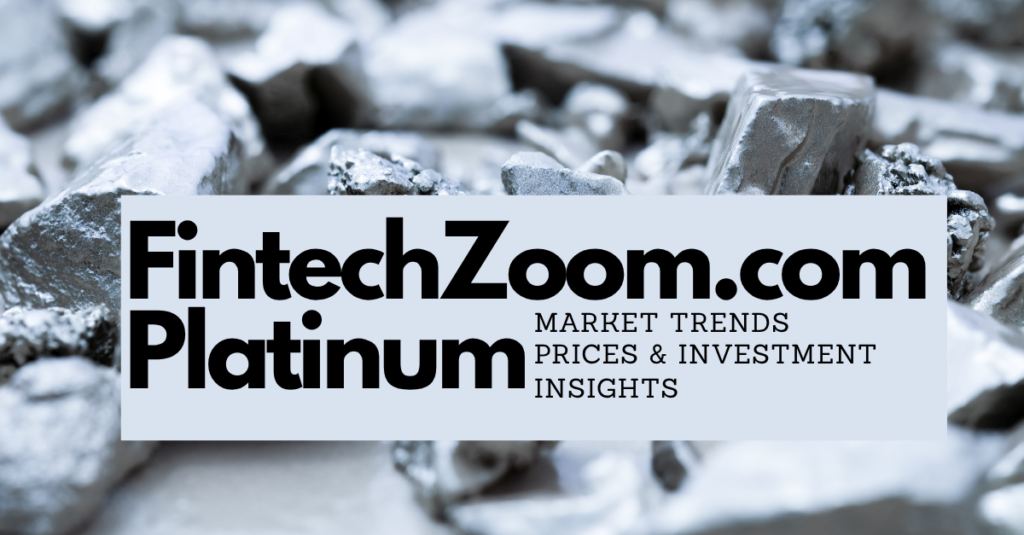Platinum is one of the most valuable and versatile precious metals in the world, known for its rarity, durability, and wide industrial use. Investors, jewelers, and manufacturers closely track platinum markets to understand price movements, supply trends, and investment potential.
- What Is Platinum?
- How Platinum Prices Are Determined
- Historical Platinum Market Trends
- Why Platinum Is a Valuable Investment
- How FintechZoom.com Tracks Platinum Markets
- Platinum Supply Dynamics
- Industrial Demand and Platinum Applications
- Investing in Platinum: Options and Strategies
- Factors Affecting Future Platinum Prices
- Risks in Platinum Investment
- Tips for Beginner Platinum Investors
- Conclusion
- FAQs
FintechZoom.com Platinum Market Trends provides real-time updates, detailed analysis, and expert insights, helping both beginners and experienced investors navigate this dynamic and evolving market.
What Is Platinum?

Platinum is a dense, malleable, and highly corrosion-resistant metal with a silvery-white appearance. It is rarer than gold and has unique properties that make it valuable for industrial applications. Unlike gold, which is primarily an investment and jewelry metal, platinum is heavily used in:
- Automotive catalytic converters to reduce emissions
- Jewelry and luxury goods
- Electronics and industrial machinery
- Medical devices
The scarcity of platinum, combined with its industrial demand, makes it a highly sought-after commodity. Investors often turn to platinum to diversify their portfolios, hedge against inflation, or speculate on industrial trends.
How Platinum Prices Are Determined

Platinum prices fluctuate based on a combination of supply, demand, and market sentiment. Several factors influence these prices:
1. Supply and Mining
Platinum is primarily mined in South Africa, Russia, and Canada. South Africa alone accounts for over 70% of global production. Any disruption in these regions, such as labor strikes, political instability, or infrastructure issues, can lead to sudden price changes.
2. Industrial Demand
Unlike gold, a significant portion of platinum is consumed in industrial processes, especially in automotive catalytic converters. When automotive production increases, platinum demand rises, often pushing prices higher.
3. Jewelry Market
Platinum is a symbol of luxury, and its demand in jewelry markets, particularly in Asia, impacts global prices. Weddings, anniversaries, and cultural preferences can influence short-term price movements.
4. Currency Strength
Platinum is priced in U.S. dollars globally. When the dollar weakens, platinum becomes more affordable in other currencies, increasing demand and pushing prices upward.
5. Investment Demand
ETFs, futures, and other financial instruments allow investors to speculate on platinum prices. Market sentiment, influenced by global economic conditions, geopolitical events, and commodity trends, can cause fluctuations.
Historical Platinum Market Trends

Understanding historical trends helps investors anticipate future price movements:
- 1980s: Prices fluctuated between $600 and $1,200 per ounce due to inflation and mining challenges.
- 2000s: Industrial growth and automotive demand pushed platinum above $2,000 per ounce.
- 2008: Global financial crisis caused a sharp drop in prices, highlighting platinum’s sensitivity to economic conditions.
- 2010-2014: Platinum peaked above $1,700 per ounce as industrial and jewelry demand remained strong.
- 2020-2023: The COVID-19 pandemic disrupted supply chains but also boosted investment demand, keeping prices volatile.
FintechZoom.com provides live historical charts and in-depth analysis to help investors identify trends and make informed decisions.
Why Platinum Is a Valuable Investment

Platinum offers several advantages for investors:
1. Scarcity
Platinum is rarer than gold and silver, making it a valuable store of wealth. Limited production ensures that supply cannot easily meet spikes in demand.
2. Industrial Usage
High demand in industrial sectors gives platinum intrinsic value, unlike purely investment metals that rely mostly on market sentiment.
3. Diversification
Including platinum in an investment portfolio helps reduce risk by providing exposure to a commodity that is not always correlated with stocks, bonds, or other precious metals.
4. Hedge Against Inflation
Like other precious metals, platinum can serve as a hedge against currency depreciation and inflation.
5. Portfolio Flexibility
Investors can gain exposure through physical platinum, ETFs, futures, or mining stocks, offering flexibility depending on their risk tolerance.
How FintechZoom.com Tracks Platinum Markets

FintechZoom.com offers comprehensive tools to track and analyze platinum markets:
- Live Price Updates: Real-time platinum pricing in multiple currencies
- Historical Data: Long-term charts showing past trends
- Market Analysis: Expert commentary on supply, demand, and global factors
- Investment Insights: Tips on buying physical platinum, ETFs, and futures
- Global News: Updates on geopolitical and industrial events affecting platinum
These resources are especially helpful for beginners who want a clear, reliable source for market information.
Related: FintechZoom.com Gold Price & Market Outlook for Investors
Platinum Supply Dynamics

Supply is one of the key drivers of platinum prices. Global production is concentrated in a few countries:
- South Africa: Over 70% of global supply, mainly from the Bushveld Complex
- Russia: Around 10% of global supply
- Canada: Smaller but significant production for industrial use
Factors that affect supply include mining labor strikes, operational disruptions, geopolitical instability, and regulatory changes. Any sudden shortage can create upward pressure on prices.
Industrial Demand and Platinum Applications

Platinum’s industrial applications directly affect market trends:
- Automotive Catalysts: Platinum helps reduce vehicle emissions, and increasing auto production boosts demand.
- Electronics: Used in sensors, fuel cells, and hard drives.
- Chemical Industry: Plays a critical role in manufacturing nitric acid and other chemicals.
- Medical Equipment: Essential in devices like pacemakers and laboratory instruments.
Industrial demand ensures that platinum prices are not solely driven by speculation, giving it a more stable value proposition.
Investing in Platinum: Options and Strategies

Investors can access platinum through multiple avenues:
1. Physical Platinum
Bars, coins, and jewelry. Physical ownership offers security but requires safe storage and insurance.
2. ETFs and Mutual Funds
These financial products track platinum prices and allow for easy trading without holding the metal physically.
3. Mining Stocks
Investing in companies that mine platinum can yield higher returns, as stock prices may increase faster than metal prices when demand rises.
4. Futures and Options
Contracts for buying or selling platinum at a predetermined price on a future date. They are suited for advanced investors willing to manage higher risks.
5. Digital Platinum
Some fintech platforms now allow fractional digital ownership of platinum, offering convenience for modern investors.
Factors Affecting Future Platinum Prices

Several trends will shape platinum markets in the coming years:
- Electric Vehicle Adoption: Platinum remains important in hydrogen fuel cells, used in some EV technologies.
- Industrial Growth: Expanding industries in Asia and other regions increase demand.
- Global Economic Conditions: Recessions or booms affect industrial and investment demand.
- Geopolitical Risks: Mining concentration in specific regions makes platinum prices sensitive to political events.
- Technological Innovation: Advances in catalytic converters and fuel cells influence industrial consumption.
FintechZoom.com monitors these factors to provide predictive insights and market forecasts.
Risks in Platinum Investment

While platinum offers opportunities, investors should be aware of risks:
- Volatility: Prices can change quickly due to economic or geopolitical events.
- Liquidity: Physical platinum can be harder to sell than ETFs or futures.
- Market Concentration: Supply is heavily reliant on South Africa and Russia.
- Economic Slowdowns: Reduced industrial activity can lower demand and prices.
Beginners are advised to start with ETFs or fractional investments and gradually expand exposure as they gain experience.
Tips for Beginner Platinum Investors

- Start Small: Begin with manageable investments to understand market behavior.
- Follow Market News: Use FintechZoom.com for the latest price updates and analysis.
- Diversify Portfolio: Combine platinum with other metals and assets to reduce risk.
- Understand Supply and Demand: Track industrial trends and mining production.
- Avoid Impulse Trading: Prices can be volatile; focus on long-term growth and stability.
Conclusion
Platinum is a rare and highly valuable metal with applications in industry, jewelry, and investment. Its price is influenced by supply concentration, industrial demand, global economic trends, and geopolitical events. Investors can access platinum through physical ownership, ETFs, futures, and mining stocks.
FintechZoom.com Platinum Market Trends provides the tools, real-time data, and expert insights necessary for beginners and experienced investors to make informed decisions. By understanding market drivers, monitoring supply and demand, and using reliable resources, investors can navigate the platinum market with confidence and take advantage of its potential for long-term growth and portfolio diversification.
FAQs
Q: Why is platinum valuable?
A: Platinum is rare, durable, and widely used in industry and jewelry, giving it intrinsic value.
Q: How can I invest in platinum?
A: You can invest through physical platinum, ETFs, mining stocks, futures, or digital platforms.
Q: What factors affect platinum prices?
A: Supply, industrial demand, jewelry market trends, currency strength, and geopolitical events.
Q: Is platinum a good investment for beginners?
A: Yes, especially through ETFs or digital platforms that reduce risk and simplify ownership.
Q: How does industrial demand impact platinum?
A: Industries like automotive, electronics, and chemicals consume significant platinum, influencing prices.
Q: Where is most platinum mined?
A: South Africa, Russia, and Canada are the primary producers.
Q: Can platinum prices be volatile?
A: Yes, prices fluctuate based on supply disruptions, economic conditions, and market sentiment.
Q: How does FintechZoom.com help investors?
A: FintechZoom.com provides real-time prices, market analysis, historical data, and investment insights for informed decision-making.




